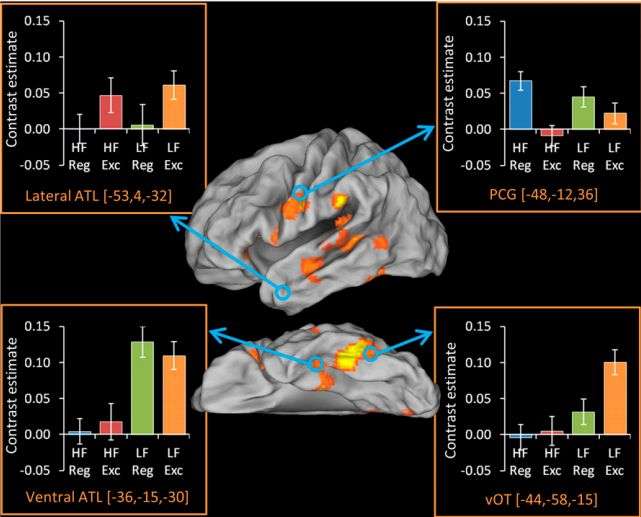July 9, 2015 report
Scientists catch a previously unknown neural culprit involved in reading

(Medical Xpress)—The Triangle Model is a widely accepted theoretical framework that comprises the basis for a number of cognitive models of word reading. It is built around three primary cognitive units that encode different types of information: semantics, orthography and phonology. Neuroscientists seek to map such cognitive models to actual neural architecture, an endeavor made possible in the last several decades by MRI technologies.
Researchers in the United Kingdom recently studied the neurocomputational architecture that underpins reading aloud, which was hitherto complicated by the difficulties inherent in scanning the lateral anterior temporal lobe (ATL) with standard fMRI. Using distortion-corrected fMRI and dynamic causal modeling, they were able to associate several brain regions including the ATL with reading aloud. This area had not previously been considered a part of the brain's reading network, likely because the region is affected by signal dropout using standard fMRI.
Despite the lack of imaging evidence in previous work, this study, published in the Proceedings of the National Academy of Sciences, focused on the ATL as a site for the representation of semantic knowledge because the Triangle Model predicts that the semantic representations supported by the ATL are critically involved in the process of reading.
The study involved 27 subjects who were asked to read aloud 180 words chosen from the Cambridge surface reading list. This is a diagnostic tool effective in identifying surface dyslexia, therefore providing ideal stimuli for studying the effects of difficult-to-pronounce words. Words were presented on a screen and participants in an fMRI scanner were instructed to read them aloud as quickly and accurately as possible. The researchers also recorded the verbal responses. All of the word reading was later compared with a baseline task in order to identify the regions that activated during reading aloud.
The researchers found that the ATL is particularly active in subjects who were reading aloud words with exceptional spelling-to-sound mappings and subjects who rely heavily on semantic knowledge to read those words. Areas of the premotor cortex involved with processing phonology exhibited the reverse pattern, and the authors believe this demonstrates a division of labor between direct and semantically mediated pathways for the conversion of words to speech sounds.
Though the study considers a number of brain structures activated during reading aloud activity, the main focus was the ATL. The authors found robust activation in the ventral ATL (vATL) during the reading of both regular and exception words. Previous studies have associated the region with the representation of conceptual knowledge. "Because the great majority of experience with written words involves reading for meaning, it is likely that this core semantic knowledge is activated automatically whenever written words are processed," the authors write.
The second ATL region studied is on the lateral surface of the temporal lobe. A previous study found that this region activates when subjects read exception words, but does not activate for pseudowords. The current study also finds that the region responds more strongly to exception words than to regular words. The authors suggest that it plays an intermediary role in mapping word meaning and speech sounds.
The researchers suggest that future studies should adopt a developmental perspective to study the origins of individual neurocognitive variations they observed in the subjects.
More information: "Triangulation of the neurocomputational architecture underpinning reading aloud." PNAS 2015 ; published ahead of print June 29, 2015, DOI: 10.1073/pnas.1502032112
Abstract
The goal of cognitive neuroscience is to integrate cognitive models with knowledge about underlying neural machinery. This significant challenge was explored in relation to word reading, where sophisticated computational-cognitive models exist but have made limited contact with neural data. Using distortion-corrected functional MRI and dynamic causal modeling, we investigated the interactions between brain regions dedicated to orthographic, semantic, and phonological processing while participants read words aloud. We found that the lateral anterior temporal lobe exhibited increased activation when participants read words with irregular spellings. This area is implicated in semantic processing but has not previously been considered part of the reading network. We also found meaningful individual differences in the activation of this region: Activity was predicted by an independent measure of the degree to which participants use semantic knowledge to read. These characteristics are predicted by the connectionist Triangle Model of reading and indicate a key role for semantic knowledge in reading aloud. Premotor regions associated with phonological processing displayed the reverse characteristics. Changes in the functional connectivity of the reading network during irregular word reading also were consistent with semantic recruitment. These data support the view that reading aloud is underpinned by the joint operation of two neural pathways. They reveal that (i) the ATL is an important element of the ventral semantic pathway and (ii) the division of labor between the two routes varies according to both the properties of the words being read and individual differences in the degree to which participants rely on each route.
© 2015 Medical Xpress

















